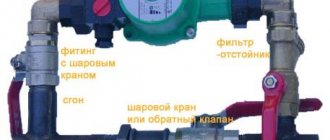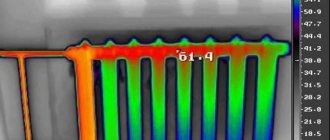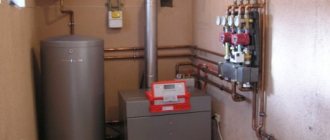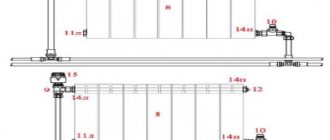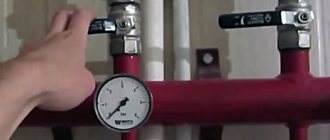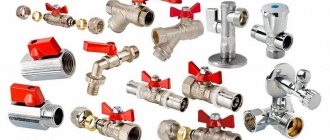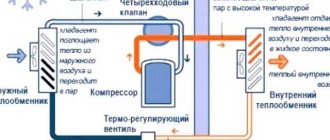Automatic air vent
Float, fully automated. Several installation options. On the side of the radiator horizontally or vertically. Without human intervention, it reacts to the total amount of water in the heating system and, when air accumulations form, automatically releases it through the valve. If the water level in the radiator drops, the float automatically opens the valve, which releases the plug. This device is very convenient and will help you eliminate emergency situations if, for example, you are away from home for a long time.
It has one disadvantage - it is sensitive to the chemical elements of water in the coolant. Due to the impurities contained in the water, it quickly becomes unusable. Breakage can be prevented by installing water filter elements and preventive inspection and replacement of the seal ring.
The installation of this automated system is suitable for use in the private sector; it does not require restarting the system or refilling the batteries. Proper use and preventative measures will increase the service life.
Closed system of a private house - how to remove an airlock
An automatic air vent is placed in the circuit through which the coolant is forced to move, operating at excess pressure. It is an element of the safety group of the heating unit and is mounted at the outlet of the heat exchanger.
Some boiler models have their own safety group installed inside the housing. All batteries located above the bottling points are equipped with Mayevsky taps or air vents. The latter are certainly needed when connecting devices diagonally or sideways. In the case of a lower two-way connection, the operation of an air-filled radiator is possible. The following method is used to bleed air from the heating system: it is forced into the upper collector, and the coolant is released through the lower one. The battery sections are heated in height due to the thermal conductivity of the metal.
The influence of air on the operation of the heating system
In addition to disrupting the normal passage of the coolant, airing causes the pipes to begin to vibrate and the connections to become loose. Sometimes even destruction occurs at the welding sites.
For example, in utility rooms, etc. After all, people are often too lazy to check the temperature in the pipes.
However, if the circulation in some batteries is disrupted, this may cause excessive fuel consumption, or even failure of the entire heating system. So, draw your own conclusions. In addition, air leads to corrosion of internal metal parts. Thus, airing reduces the service life of the system. In particular, it leads to leaks and breakdown of various equipment.
Why is air in the system undesirable?
Airy radiators. This is a common problem with water heating systems. Many of us have encountered it. You can easily check whether the radiator is airy. Just try to see if it is heated evenly over the entire surface. If the top is cold and the bottom is warm, the radiator is not full of water. If there is air in part of the radiator instead of water, the thermal efficiency of the radiator is reduced and the room in which it is installed is not fully heated. Most often, radiators located on the top floor or below the distribution network become airborne. The noisy operation of the system, although not as unpleasant as cold radiators, can also annoy residents. Noise, crackling and bubbling from an over-aired system are unpleasant to the ear. Corrosion.
Cold radiators and noisy system operation are immediately noticeable to users. Another consequence of airing the system - corrosion - makes itself felt only after a certain time. The air contains about 20% oxygen, which is the main cause of corrosion, as well as carbon dioxide, the presence of which is undesirable in heating equipment. An additional reason for the presence of carbon dioxide in the heating system is the breakdown of dissolved calcium and magnesium bicarbonates. When exposed to elevated temperatures, they break down into calcium and magnesium carbonates, which are deposited in the form of stone, as well as carbon dioxide, which can form carbon dioxide, which is aggressive in terms of corrosion.
Pump is not working properly. Air not only shortens the life of radiators and pipes, but also causes the circulation pump to malfunction. The plain bearings of the pump shaft are “lubricated” with water. If the flow of water is interrupted by an air lock, the phenomenon of “dry” friction occurs. In this case, the heat generated due to “dry” friction in the bearings can damage the shaft or sliding rings of the pump. Therefore, when starting the pump after a long break in operation (for example, after the summer season), it is necessary to bleed air from the system.
Open heating system in a private house
Such a system operates when the pressure and height of the water column formed by the lower and upper points of the heating circuit correspond. In this case, the bottling is arranged at a constant slope, and an open expansion device is located at its highest point.
It combines a number of functions:
- expansion tank, which compensates for the increase in liquid volume when heated;
- a safety valve that serves to relieve excess pressure in the event of water boiling in the heat exchanger of the heating unit;
- an air vent, thanks to which the problem of how to expel air from the heating system is solved - it must be forced into the upper part of the circuit, or rather into the expansion tank, from where it is sent into the atmosphere.
How to expel air from a heating system with an open type pump: diagram
Open circuits are rarely used in modern circuits. However, they can still be found in old houses. They are modernized by installing circulation pumps, which increase heating efficiency due to the forced movement of the coolant. Although Leningradka-type heating systems provide for natural bleeding through the expansion tank, gas may accumulate in radiators or pipe bends.
If there is a pump in an open-type heating circuit, it is possible that its operation prevents the natural exit of air when the directed flow of liquid “locks” it, preventing it from rising upward. To bleed the gas, turn off the pump unit for a short time. When the flow of liquid stops, air will freely rise into the expansion tank.
Important!
The pump is turned off after stopping the boiler unit. If you use a solid fuel heater, the procedure is carried out after it has cooled down so that the water does not boil.
When sectional radiators are installed in an open circuit, a plug may form in them. In this case, stopping the pump will not have the desired effect. To completely fill the radiators, a relief valve is installed on them. Reset is performed by unscrewing the cap until liquid drops appear.
Where should air vents be installed?
The installation principle is vertical, not horizontal. In order to remove the annoying air lock without any problems, it is necessary, first of all, that the installed air vents be installed in the right places. Namely:
- at the highest point of the highway
- in collector heating - on each ridge
- in case of triple wiring - in front of each branching node of the system. But after installation, you need to set the correct pressure value at which the counter will operate. When getting rid of an air lock in an autonomous heating system, first reduce the temperature of the coolant to a minimum value, which will lead to a decrease in the volume of water and this will help to effectively eliminate the problem.
Also automatic.
Bottom Filling with Administrator Access - Air Lock Removal
It’s one thing if the problem can only be solved from your own apartment or by contacting specialists. It’s another matter if you can play the role of a specialist yourself, for example, by gaining access to the basement.
The solution to the problem in this case is as follows:
- Before removing air from the heating system, it must be bypassed, for which the heating valve is first closed and the sewer discharge located underneath is opened;
- After completing the previous steps, the system should be given about 5-10 minutes to release air;
- If the desired effect is not achieved, the system must be turned in the opposite direction;
- After bleeding the air, you need to close the vent and return all valves to their original positions so that the heating circuit continues to function as normal.
Individual risers with which problems have arisen can also be transferred from the basement level. To do this, it is enough to close the valve of one of the connected risers and open the discharge. The probability of successful bleeding of air in this case is quite high, and if one of the risers is used as an idle pipe, then the work will certainly be crowned with success.
Even if plugs are installed on the risers instead of vents, there are a couple of ways to get rid of an air lock in the heating system:
- The first option is to shut off both risers, reset them, and then replace one of the plugs with a ball valve with a male-female thread. Of course, this option will require the faucet itself - but its cost is low, and such costs are certainly worth it so that the heating system can continue to operate.
- For the second option, you need to close the valves located on the risers, and then unscrew one plug. The riser is put into reset mode, stops, and then the previous operations are repeated in reverse order. This method of bleeding air can only be used when the coolant temperature is below 45 degrees - otherwise the person performing this work may be seriously burned.
Determining where air locks form
An important part of removing air from the system is correctly identifying where the airlock is occurring. Depending on the location of the air, different methods of removing it are used.
In any type of heating system, air pockets can form in two places: in pipes and radiators. In pipes, an air lock usually forms in the outer risers, where the difference in supply and return pressure is minimal. In radiators, air accumulates in the upper corner located opposite the supply connection.
The first thing to start with is to make sure that all the valves on the risers and heating radiators are open.
If on the riser next to the heating radiator there is a jumper (bypass) connecting the supply and return, bypassing the radiator, then first check it. If it is hot and the radiator is cold, then there is an air lock in the radiator. If it is cold, it means that the entire riser is not working.
Fig.1.
If there is no jumper, then compare the supply and return temperatures. If both pipes have the same temperature, then the problem may be in both the riser and the radiator. In this case, we first try to bleed air from the radiator. If the supply is warmer than the return, then there is an air lock in the radiator. Because of it, the entire riser does not work.
What signs indicate the presence of air in the system?
First, you need to make sure that the reason for the ineffective operation of the heating system is air pollution.
The following signs indicate this:
- Noise appears in radiators and pipes. This may be a humming or gurgling sound, which is a telltale sign of air accumulation.
- Batteries warm up unevenly. This situation occurs not only when the radiator is filled with air, but also when the radiator is clogged with deposits. It is not difficult to distinguish one from the other. When airborne, both the radiator and the pipeline will be cold, and if the device is clogged, the pipes will be hot and the battery sections will be cold.
- The pressure in the system may decrease. If air enters the circuit during depressurization, then there will be leaks in this place, and the overall pressure in the line will be reduced. You need to carefully inspect all connections and tighten them tightly. If a leak is not detected, then it is worth looking for it along the pipeline and in heating devices.
Where does the air in the system come from?
Gases soluble in water.
Heating systems in private homes are usually filled with tap water. In such water (taken from the water supply, or from your own well - which does not matter at all), in addition to calcium and magnesium compounds, there is dissolved air. When we fill the system with water, we unwittingly introduce air into it. The amount of dissolved air is related to the temperature and pressure of the water. The lower the temperature of the water, the higher the content of dissolved air in it. And the higher the water pressure, the better the gases dissolve in it, and more air will enter the system.
Diffusion. Not all materials are gas-tight. For example, polyethylene or polypropylene can allow oxygen to pass through the air. Pipes made of such materials used in water heating systems must have an anti-diffusion layer (coating) that does not allow oxygen to penetrate the system.
Incorrect filling. The system must be filled slowly, while removing air from the radiators and distributors. Filling too quickly leads to gas bubbles entering the water and causing air pockets. We must act on the principle: the more extensive and ramified the system, the slower it is filled. In practice, you need to assume that the system on one floor takes about an hour to fill. Tightness. Small flaws in the system are invisible. During operation of the system, it is difficult, for example, to notice a leak at the connecting joint, since hot water quickly evaporates. Through such small leaks, air is sucked into the system.
Rules for refilling coolant liquid
If the heating system is constantly filled with water, the formation of air, or more correctly, gas, plugs in it is possible only during fairly specific processes. In most cases, heating occurs during the process of pumping coolant, so powering the system must be carried out in compliance with a number of rules.
The water supply pipe must be cut into the lowest point of the system, usually this is the return section immediately next to the boiler or additional outlets of the collector units. It is advisable that a valve be installed as a shut-off valve rather than a ball valve. This is due to the fact that water needs to be supplied under low pressure, and the valve helps in regulating the flow as well as possible.
When water enters the pipeline system, it will squeeze out air and for this it is necessary to provide an outlet pipe. It should be located at the highest point of the system and mounted vertically. It would be good if, after the tap, a fitting with a hose is packed, the end of which is lowered into a bucket of water placed on the floor. Then the signal about the end of power supply will be the cessation of the formation of air bubbles squeezed out of the system.
Before draining water from the system, it is recommended to shut off all looped areas: circulation pump, closed expansion tank and radiators. If they remain filled during repair work, this will slow down the corrosion of metal surfaces and eliminate the formation of plugs during refueling of the system.
Airing of the system - what is the reason?
As experience shows, the correct search for the cause of such a phenomenon always leads to the identification of the root cause of the phenomenon itself and allows in the future to simply eliminate the causes, not the consequences. An air-filled heating system in a private home, regardless of whether the heating system is open or closed, has several groups of causes for the occurrence of this phenomenon:
- technological;
- constructive;
- mechanical.
Technological reasons for the occurrence of air locks in home heating system devices include:
- improperly carried out routine maintenance to fill the coolant into the system;
- incorrect operation of heating equipment;
- using untreated water or low-quality antifreeze as a coolant.
Most often, hasty filling of the system volume with coolant leads to the formation of air gaps in the radiators and system pipelines.
Emergency, avalanche-like filling leads to the filling of the main volumes with water at a rapid pace, when water cannot displace air, but, on the contrary, clogs it in the cavities of the system. In addition, filling the system volume without subsequent bleeding of air during a test fire only enhances the effect. Incorrect operation of the heating system should mean irregular combustion, the coolant reaching its maximum temperature, followed by the discharge of part of the coolant into the expansion tank and then beyond the system volume. In this mode, when the maximum temperature at which water “boils” in the boiler is reached and not only the coolant, but also water vapor escapes into the expansion tank, after cooling as the water level drops, an air gap is formed, which is drawn into the system during the subsequent increase in temperature.
Unprepared tap water, simply put, which has not settled and has not released all the air it contains during the process of heating and circulation through pipelines, forms air bubbles that accumulate at the top points of radiators and pipelines. Such plugs do not allow the system to “push through” hot water, significantly reducing the coolant circulation ring.
Structural reasons include reasons associated with improper design and assembly of the entire system during construction:
- incorrectly calculated angles of inclination of pipelines;
- errors in system design;
- lack of automatic air vents and Mayevsky taps on each heating radiator;
- the absence at the highest points (as a rule, this happens when installing a closed-type heating system) of valves for bleeding air.
Mechanical causes include those resulting from damage to the integrity of the system - cracks, depressurization of threaded connections, loose closure of taps, in general, reasons in which air will constantly flow into the system.
Determining the location of gas accumulation
To eliminate an air pocket, you first need to determine where it formed. In total, we can distinguish two sections of the system in which air pockets can form - these are horizontally directed pipelines and radiators.
In properly designed and installed heating systems, radiators may be the only place where air accumulates. The formation of plugs in them is accompanied by the appearance of noise - the murmur of flowing water. Another evidence may be the absence of a correct temperature drop gradient from the upper zone to the lower: since air has accumulated at the top, the water does not contact the walls and does not heat them, but the lower part is quite hot.
Determining air in pipes is more difficult. Since no turbulence is formed in the straight section, the formation of a plug is not accompanied by extraneous noise. The only way to determine the presence of air is to note a decrease in coolant flow. In other words, confirmation will be insufficient heating of radiators located along the flow of the coolant after the problem area. In this case, shutting off the radiators located before the plug will not lead to increased flow and an increase in the temperature of the remaining heating devices.
Bottom heating supply in a high-rise building
For modern buildings, the standard solution is a bottom filling scheme. In this case, both pipes - supply and return - are laid in the basement. The risers connected to the bottlings are combined in pairs using a jumper in the attic or upper floor.
Option No. 1 to solve the problem - start the elevator for dumping
Bleeding air from the heating system is carried out by housing and communal services specialists at the stage of starting the circuit, which is partially or completely vented. For this purpose, it is discharged: one valve is opened, and the second is left closed.
From the side of the heating circuit, up to the closed valve, open the vent, which is connected to the sewer. The fact that most of the air has escaped can be seen from the water flow in the discharge - it moves evenly and without bubbles.
Option No. 2 to solve the problem - installing an air vent
Before releasing air from the heating system, an air vent is installed in the upper part of all paired risers in the case of bottom filling. It can be not only a special Mayevsky tap, but also a screw valve, a water folding or ball valve mounted with the spout facing upward.
Venting air from the heating system is performed in a certain sequence:
- Open the tap more than one turn. The result should be a hiss of moving air.
- Place a wide container under the tap.
- They wait for water to flow instead of air.
- Close the tap. After 10 minutes the riser should warm up. If this does not happen, you need to bleed the plugs again.
Before getting rid of air in the heating system, you should remember these important rules:
- In the Mayevsky tap, you cannot unscrew the screw completely, since with a pressure of 5–6 atmospheres and boiling water pouring from the hole, it is impossible to return it to its place. The result of such actions may be flooding of your own apartment and that located below.
- There is no need to unscrew the air vent under pressure, even half a turn, since it is unknown what condition its thread is in. When a drain valve is faulty, before replacing or repairing it, you should shut off the two paired risers and ensure that their valves are holding water.
- If you live on the top floor, before the start of the heating season, you need to make sure that you have a tool that works with the air vent. Models of modern Mayevsky taps can be opened with a screwdriver or by hand, but in older buildings a special key will be required. It is easy to do - you just need to take a rod of the required diameter and make a cut at its end.
Option No. 3 to solve the problem - bypass the heating riser to discharge
With lower bottling, the main problem with air vents is that they are located on the upper floors of apartments. If their owners are constantly away from home, how to remove airiness from the heating system?
You can bypass the paired risers from the basement side, for which:
- They are examined for the presence of valves, after which plugs or vents can be installed. In the second case, there will be no costs, but in the first case, you need to buy a ball valve with a thread of the same size as the plugs.
- Shut off the valves on two risers.
- At one of them, unscrew the plug a few turns and wait for the pressure of the liquid that hits the thread to decrease. This way you can make sure that the valves on the floors are working properly.
- A ball valve is mounted in place of the plug, first winding up the threads.
- The mounted vent is opened completely.
- Now open the valve located on the second riser. When the pressure removes air from the heating system, close the vent and open another riser.
There are also some nuances to this:
- When all the batteries are installed on the supply riser, but there are none on the return riser, the dumper needs to be mounted on the return and then the problem of how to remove the air lock from the heating system will be solved. If radiators are located on paired risers, it is not always possible to remove the air.
- If it is not possible to bypass the risers in the same direction, then the vent is moved to the second riser and the coolant is transferred in the opposite direction.
- If there are screw valves on risers, it is necessary to avoid moving water through them in the direction opposite to the arrow on the body. The desire to slightly open the valve with the valve pressed down may result in its separation from the stem. To fix the problem of how to bleed air from a heating system, it is quite common to reset the building's heating system.
How to shut off the heating riser and start it after repair
To repair risers, it is necessary to first reset the system, and after completion of the repair work, a restart is carried out. The implementation of these operations must occur according to a certain algorithm.
Bottom filling
First you need to find the appropriate valves.
You can find them by focusing on the flights of stairs and the layout of heating devices. If necessary, you can go up to the top floor and see how the jumper is located. To discharge the risers, it is necessary to unscrew the plugs or open the relief valves. Having completed this work, you can close the discharges and very slowly fill the system with water. The slowness of this process is due to the fact that when the system is quickly filled, a water hammer can occur. If there are screw valves, the water must move in the direction indicated by the arrow on the body - otherwise the valve may break, after which you will have to reset the heating system in the entire house.
Then you can open the valves completely and relieve the air pressure on the upper floor. The Mayevsky valve is usually located in the radiator plug or in the upper part of the jumper. Resetting and starting will be greatly simplified if all valves installed in the system are ball valves.
Top filling
In this case, starting the heating is much easier, but resetting the system will require much more steps.
First, the attic riser is blocked, and after that - installed in the basement. Now you can open the reset. To prevent a possible mistake when turning off the system in the attic, it is worth starting from the number of taps into the bottling from the located reference point. Having completed the work, you can close the discharge and very slowly fill the riser. It is imperative to observe the direction of water movement. Now you can open both valves. There is no need to bleed the air: it will move itself into the attic expansion tank.
You can use corrugated stainless pipe for repairs. It has less strength than galvanized steel, but is significantly superior in ease of installation. Good and easy installation is ensured by good flexibility and the presence of fitting connections. Most of the pipes produced can withstand pressure of at least 15 atmospheres.
The use of plastic or metal-polymer pipes is not recommended. One of the main reasons is the increased risk of water hammer due to improper operation of shut-off valves or malfunctions. About
Device for removing air from radiators
To facilitate air outlet, an additional hole was made perpendicular to the main channel. The air actually comes out through it. When deflating using a Mayevsky tap, point this hole upward. After this you can unscrew the screw. Unscrew it a few turns, but do not unscrew it too much. After the hissing stops, return the screw to its original position and move on to the next radiator.
When starting the system, it may be necessary to bypass all the air collectors several times until air stops escaping altogether. After this, the radiators should heat up evenly.
Automatic air release valve
These small devices are installed both on radiators and at other points in the system. They differ in that they allow you to bleed air in the heating system automatically. To understand the principle of operation, consider the structure of one of the automatic air valves.
The operating principle of the automatic release is as follows:
- In normal condition, the coolant fills the chamber by 70 percent. The float is at the top, pressing the rod.
- When air enters the chamber, the coolant is forced out of the housing and the float lowers.
- He presses the protrusion-flag on the nozzle, squeezing it out.
- The depressed jet opens a small gap, which is enough to allow the air that has accumulated in the upper part of the chamber to escape.
- As water comes out, the air vent body fills with water.
- The float rises, releasing the rod. It returns to its place due to the spring.
Various designs of automatic air valves operate on this principle. They can be straight or angular. They are placed at the highest points of the system and are present in the security group. They can be installed in identified problem areas - where the pipeline has an incorrect slope, which is why air accumulates there.
Instead of Mayevsky's manual taps, you can install an automatic drain for radiators. It is only slightly larger in size, but works automatically.
Removing an air lock from a heating radiator
Heating radiators are more susceptible to air condensation than other elements of the system. In most cases, it is enough to bleed the air from the radiator, and the heating system begins to function properly.
There are two ways to remove air from the radiator:
- through an air vent or valve;
- restart the heating system.
If the heating radiator is equipped with a valve (Mayevsky tap), then you can remove air from the radiator with your own hands. All modern heating radiators are equipped with an air vent or valve. The air vent is installed on the top radiator cap on the side opposite the supply pipe.
Fig.2.
Mayevsky tap on a heating radiator.
To bleed air, you need to use a special key, sold together with the valve, to open the nipple. If there was air in the radiator, you will hear a hissing sound. Before opening the valve, place a container under it to receive water. There will not be a lot of water, so a liter jar will be enough.
When the hissing stops, it indicates that the air has escaped. Next, you should wait for water to appear from the nipple. As soon as the water pressure from the nipple becomes constant, it can be closed. There is no more air in the radiator.
If the air vent is missing, the heating system must be restarted. In the case of a city central heating system, it is difficult to restart it on your own and you should call specialists. You can restart your individual heating system yourself.
How to get rid of an air lock
Unfortunately, the air lock is not always in an easily accessible place. If there are design or installation errors, air can accumulate in the pipes. It is very difficult to get him out of there. First we determine the location of the plug. In the area of the plug, the pipes are cold and a babbling sound can be heard. If there are no obvious signs, they check the pipes by sound - tapping on the pipes. In a place where air accumulates, the sound will be louder and louder.
Any air lock found must be removed. If we are talking about the heating system of a private house, this is done by raising the temperature and/or pressure. Let's start with pressure. Open the nearest drain valve (in the direction of flow of the coolant) and the make-up tap. Water begins to flow into the system, increasing the pressure. It forces the traffic jam to move forward. When air gets to the bleeder, it comes out. Stop feeding after all the air has escaped - the drain valve stops hissing.
Starting/restarting the heating system
Starting a heating system is a simple, but long and responsible process. Its main task is to fill the system and at the same time remove all air from it. The system startup procedure is as follows.
They start with preparatory work. Every heating system has an air vent. Manual or automatic. It is located at the very top of the system and must be operational. In the case of a manual air vent, it is open.
Next, close the supply pipe. The system is filled through the return line. Under the influence of water, the air tends to rise to the highest point of the system, to where the air vent is located. If you don't rush, all the air will come out the first time.
If we are talking about restarting the system, then do the same. Shut off the supply, open the air vent and open the return. Water, rising up through the pipes, squeezes air out of the system through the air vent. You can determine whether the air remains or all has escaped by the uniformity of the water pressure from the air vent. If the pressure is uniform, then the air has been removed. The air vent can be closed and the system can be turned on for circulation.
Typically the manual air vent is a faucet. Through this tap, water will flow out along with the air. For an urban central heating system, losing several hundred liters of water is not a problem. For a private home where antifreeze is used instead of water, this is unacceptable. Therefore, automatic air vents are installed in individual heating systems. They allow air to pass through, but antifreeze does not pass through.
Fig.3.
Automatic air vent for heating system.
This is a security group. An automatic air vent is installed at the middle outlet
Not all air locks give up so easily. For particularly stubborn ones, it is necessary to simultaneously raise the temperature and pressure. These parameters are brought to values close to maximum. You cannot exceed them - it is too dangerous. If the plug does not go away after this, you can try to open the drain valve (to drain the system) and the make-up valve at the same time. Maybe this way it will be possible to move the air lock or get rid of it altogether.
If a similar problem occurs constantly in one place, there is an error in the design or wiring. In order not to suffer every heating season, a valve is installed in the problem area to remove air. You can cut a tee into the main line and install an air vent at the free entrance. In this case, the problem will be solved simply.
How to get rid of air during operation?
In this situation, you first need to determine where the air in the pipes comes from. This is due to 2 signs:
- the appearance of cold sections of pipes and radiators;
- babbling noises in the highway.
When the approximate location of the plug has been found, we go up the pipe to the nearest automatic or manual valve. Then, opening the feed tap slightly, we bleed the air through this device. Removal from the battery occurs in the same way.
Unfortunately, this standard method does not always work. As a last resort, you can try to squeeze the air out of the uncomfortable place by increasing the temperature and pressure in the system to values close to the maximum. Then proceed according to the standard scheme, often the plug moves from its place and still ends up in the relief valve. But if this does not help, you will have to bleed the air through the nearest detachable connection. This must be done extremely carefully so as not to get burned and flood the whole house.
Causes of traffic jams
Before fixing the problem, you need to understand why the heating system in a private house or apartment is airing. The reasons may vary depending on whether we are talking about individual or centralized heating.
Factors that cause central heating to air out:
- depressurization;
- water leak;
- design errors.
The system may become airtight due to depressurization, which could occur as a result of repair work.
The system may become depressurized during scheduled repairs, during the replacement of parts of pipes and radiators. Another reason why the heating system will air is when air gets into the pipes during drying. Errors and errors made at the design stage lead to pipe routing or battery installation being performed incorrectly. As a result, the pipeline will be constantly aired.
Individual heating structures are aired less often. The reason most often lies in an incorrectly drawn up project. In order for water to circulate freely in the pipes, they are made at a certain angle. Compliance with this condition protects against the occurrence of air jams. A necessary element of the system is an expansion tank. It is needed to control the water level and add it if necessary.
It has been noticed that the formation of an air lock is typical for the first start of heating. As water enters the pipes, air must be removed. To do this, a tap is attached at the highest point, and a hose is connected to it. When the pipes are filled with water and air stops coming out, close the tap.
You will see about the concept of airing the system in this video:
Types of air vents
There are two types of air vents:
- Manual. Models of this type include Mayevsky cranes. A device installed on the end of the radiator allows air accumulations to be removed.
- Automatic. Such air vents operate without human intervention, which greatly simplifies the process of de-airing the system.
Manual air vents
Air removal using such devices is widespread in old multi-apartment buildings. In such houses, lower piping is usually used, which often leads to a disruption in the circulation of the coolant. This happens as a result of airing the upper part of the heating network.
To solve the problem, a device (Maevsky tap) was invented that allows air to be removed from the problematic part of the system. The faucet is mounted on any battery and is controlled manually using a screwdriver or key.
Mayevsky cranes are not without their drawbacks:
- Air removal must be carried out by all residents separately. The problem is solved by installing shut-off valves at the highest point of the system. Thus, the venting is carried out by the operating organization of the house, and not by individual residents.
- The devices are small in size and therefore not very productive. Such taps can only be used to remove small local plugs.
Another option for bleeding air from an air bleed battery is a separator. This device, unlike the Mayevsky tap, does not remove air from the upper part of the network, but removes it directly from the liquid. Air separators are usually combined with slurry separators. The latter are used to clean the coolant from grains of sand, scale and rust. This tandem is especially useful in a highly ramified heating system.
Automatic air vents
Automatic devices are installed both vertically and horizontally. The principle of their operation is the reaction of a special float to liquid pressure. When air accumulates, the float drops to the level of the liquid and opens the valve connecting the system to the external environment. In this case, the air is squeezed out by the water. As the water level rises, the float that closes the valve also rises. Thus, a new cycle of operation of the device starts.
Due to the automatic valve, such devices have high performance. The disadvantage of automation is sensitivity to mechanical inclusions in liquids. Impurities accumulate on the valve needle, resulting in incomplete closing of the mechanism, which in turn leads to leaks in the body. Therefore, the use of automation is justified only in combination with cleaning filters.
Stable operation of the heating system ensures comfortable living in the house. Therefore, excess air must be removed on a regular basis.
Airing a water heating system is an unpleasant incident that is quite difficult to foresee. You need to get rid of air jams as soon as possible, so today we will talk about the most vulnerable places and suggest methods for quickly eliminating the problem.
Explain to plumbers how to bleed air from a heating riser
In general, there is a house - a brick Khrushchev building on the 4th floor, built in the late 60s and early 70s, and a relative’s apartment on the 3rd floor. There is a riser with cast iron batteries (the connection is one-way, with a bypass, the battery has a regular valve, which naturally cannot be rotated), next to it there is a return line. The riser is cold, the return is barely warm, the rest of the batteries seem to be more or less. All my life the neighbor above me let the air out, but now this freak refuses to let anyone in. Once the REU plumbers finally got through to it, they seemed to let the air out, but an hour later everything returned to normal - nothing was heating again. The plumbers said that they no longer want to get to the upper tenant, and are going to bleed the air on the 3rd floor (?!). When asked about the fact that, in fact, they had been lowering upstairs all their lives, the plumber said, I quote, “I’m a new Russian, and I’ll do everything in a new way.” The lack of a tap did not bother him. Naturally, my relative didn’t let me do anything, she’s generally very old and she doesn’t go anywhere much, so I need to decide everything. Now the idiots have a new obsession, they want to get into the storage room (in the basement) under this riser (she is just a relative) and release the air there (strange, for some reason all my life it seemed to me that the air was rising to the top point of the system, but the new Russian plumbers have laws physics is apparently unwritten). In the storage room (corner) there are two types of main pipes running horizontally along the outer wall, this riser branches off from them, there are only taps that shut off the riser and the return (the tenant of the first floor installed balls, why - the devil knows). And also, could it be that the tenant on the first floor pushed up this corner section of pipes in our closet and in the neighboring ones during the process of replacing the risers with copper (more precisely, they were pulled up by the plumbers who worked for him) - now I understand that this corner is the highest in the entire basement? This is especially true for the return, as I understand it. So, actually, can someone clearly and briefly explain how this all works (or at least how to determine the type of heating system by external signs - I read a smart book on plumbing here, but didn’t really understand something) and what mechanics need to do to Could I briefly explain to them the essence of their work, or at least explain convincingly that they have nothing to do in the pantry? Because these idiots don’t seem to care where to turn what and why, they live in the next basement, they are not even able to repair, I’m not kidding, the hose near the shower. I read it in the search, but it all comes down mainly to the situation when there is access to the air vent.
Carrying out repair work
If you discover signs of air in the heating system, you should not immediately start getting rid of it. First, check the circuit for integrity and tightness. After all, if there are leaks, problems will continue.
Coolant leak
Coolant leakage is the loss of fluid that occurs due to loose connections and damage to the circuit.
Photo 1. Leak in the heating system pipe. Such a problem can cause poor operation of the heating structure.
Possible leak locations and solutions:
- Pipe sections. To stop the leak, clamps and cold welding are used. If the pipe is plastic, the entire section is replaced.
- The joints between parts of the system are sealed. Welding is used.
- Loose connection of radiator sections. You will have to remove the battery and tighten the connections (on aluminum). Cast iron radiators are glued with a cloth containing epoxy resin.
This is a labor-intensive part of the work of preparing the system for the heating season. But this must be done, otherwise you may be left without heat in winter.
A constant loss of coolant will lead to unstable operation of the system.
Features of the underfloor heating system
The presence of a heated floor complicates the system; it is not easy to remove air from the floor loops.
Air plugs appear due to:
- reducing pressure;
- strong heating of the coolant;
- leakage formation;
- violation of the tightness of connections;
- errors made during installation (uneven surface, pipe slope, errors in the organization of the collector);
- illiterate first launch of the system.
In order for the system to start correctly, the air is bled from it before the boiler is turned on and the coolant is heated.
If a warm floor is the main means of obtaining a comfortable temperature, then air should not be allowed into it.
Attention! A conventional system works even if there is air there. Efficiency will decrease, but heat will still flow
When air appears in the circuit, the floor will stop heating - the reason for this is the complex installation and small diameter of the pipeline.
Removing air from the floor circuit is a lengthy process:
- Only one circuit on the collector is turned on.
- The pressure is built up above the working pressure (15-20%).
- The circulation pump starts at low speed. It takes some time to fill the circuit so that the coolant displaces the air. Then the next circuit is activated, so one by one all the branches passing through the collector are slowly filled.
- The process lasts several days. This is repeated until all the air is released.
- This is done with cold coolant; heating is turned on only when it is certain that the air has completely escaped.
Reference. When installing the system, it is useful to think about equipping the floor circuit with a separator - a device for automatically removing air from the pipes.
Coolant renewal frequency
Liquid is an important component of heating that must be used correctly.
Periodic replacement is necessary, but should not be overused. The optimal shelf life of liquid in pipes is 12 months, subject to mandatory draining of the system.
Synthetic coolants: propylene glycol, ethylene glycol remain in the system for up to 7-8 years.
Photo 2. Canister with synthetic coolant for the heating system. This substance lasts longer than ordinary water.
The concentration of synthetic compounds in the liquid extends the shelf life of the coolant. But if there is no need to use antifreeze, then you can get by with plain water.
The replacement time will be determined by coarse filters: if they do not need to be washed and replaced, then the water in the system is also suitable and does not need to be changed.
This is important because each fresh portion of liquid is a fresh set of salts and impurities, oxygen, which reacts with new forces with internal surfaces, settling on them in layers that gradually reduce the efficiency of the system. Important! The water that is already in the circuit is a prepared liquid, without impurities and active substances
The fact that the water has changed color does not change its value - it has already undergone reactions, has become inert and is now an optimal addition to the efficiency of the system
Important! The water that is already in the circuit is a prepared liquid, without impurities and active substances. The fact that the water has changed color does not change its value - it has already undergone reactions, has become inert and is now an optimal addition to the efficiency of the system
If the radiators are clogged, you can remove them for cleaning without draining them; just turn off the valves.
Causes of air
The logical question is: how does air get into the heating system if it is completely sealed?
There can be many reasons for this phenomenon:
- High blood pressure. Water contains not only magnesium and calcium, but also oxygen. The volume of oxygen depends on the pressure level in the system. As pressure increases, the concentration of oxygen in water increases.
- Violation of requirements for pipe slopes during installation work.
- Incorrect filling of the pipeline, leading to air congestion. Water should be supplied slowly while air is pumped out of the batteries, right? otherwise, the formation of bubbles is inevitable, which causes airing of the heating system. The general rule is: the more branches a system has, the slower its filling should occur.
- Diffusion. This phenomenon is a process during which the ability of molecules of one substance to penetrate between the molecules of another is realized. In the described case, we mean the penetration of oxygen molecules between the molecules of polypropylene or polyethylene. To prevent diffusion, special coatings are applied to the pipe material.
- Insufficient connection density between system elements.
- Faulty or missing air vents.
- Carrying out repair work during which depressurization occurred.
- Corrosive processes leading to violation of the tightness of equipment.
The above factors do not exhaust the reasons that cause air in the heating system, but they are the most common.
Bleeding air from radiators
The formation of air pockets can occur even if not the entire system has been drained, but only a separate section of it, for example, a radiator. In this case, refilling with water should be carried out in the following sequence:
- Loosen the top inlet fitting or open the drain valve to allow air to escape unobstructed.
- Open the bottom tap and feed the radiator until the escaping air is replaced by water.
- Pack the top fitting and open the top supply valve.
In addition, all radiators of closed systems, as well as systems with bottom wiring, must be equipped with Mayevsky taps. It is through them that the main volume of air is vented during refueling, since the upper outlet of the radiator is nothing more than the highest point of such a system.
Please note that aluminum radiators can, in some special cases, serve as a source of gas for plugs. The fact is that with a high content of dissolved ions in water and the presence of electrical emission, aluminum quickly corrodes, releasing hydrogen in a significant volume
If you are faced with an indirect source of gas formation, exclude any contact of electrical equipment with the system and ground its metal parts.
